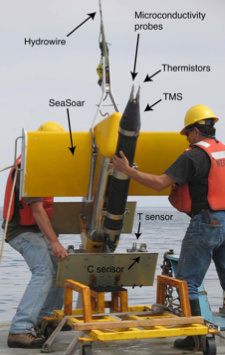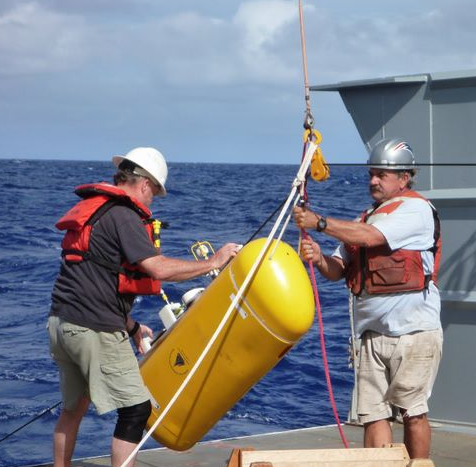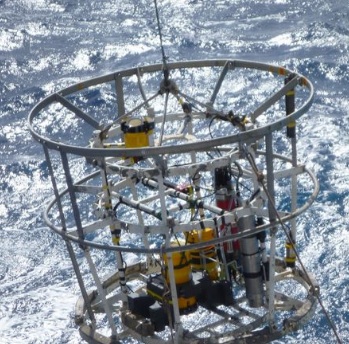INSTRUMENTS
Spray was developed by Russ Davis and the Instrument Development Group at Scripps Institution of Oceanography. More information on the glider is at spray.ucsd.edu.

As the glider profiles to 1000 m, it moves through the water at 25 cm/s and measures temperature, salinity, chlorophyll fluorescence, and depth-mean current. When equipped with an acoustic Doppler profiler Spray profiles to 500 m and measures depth-varying currents at 4 m resolution. Iridium satellite communication allows data transmission at surface intervals and the possibility of retasking the glider. Spray navigates via the global positioning system (GPS). Near realtime plots of the data are at spray.ucsd.edu.
More information on Spray can be found in:
The autonomous underwater glider 'Spray'
IEEE Oceanic Eng., doi: 10.1109/48.972076, 26, 437-446, 2001
J. Sherman, R.E. Davis, W.B. Owens and J. Valdes
SeaSoar
The SeaSoar is equipped with a conductivity-temperature depth instrument (CTD), fluorometer, transmissometer, and oxygen sensor. SeaSoar is a towed at 8 knots and makes sawtooth profiles to depths of 400 m with horizontal resolution of about 4 km. Typically the SeaSoar is towed about 700 m behind the ship and transmits data up the hydrowire. The SeaSoar is yellow and has wings to control its pitch. The wings are moved by a hydraulic unit, which is powered by the impeller on the aft end of the SeaSoar.

Transmitting microstructure system (TMS)
The TMS (black) is mounted under the SeaSoar and is equipped with fast thermistors and microconductivity sensors to measure centimeter-scale temperature gradients. The microconductivity sensors and accelerometers sample at 2048 Hz while the thermistors and pressure sensor sample at 512 Hz. The TMS was manufactured by RGL Consulting.
Underway CTD
The UCTD allows high-resolution profiling while underway. More details can be found in a publication by Rudnick and Klinke or at the Oceanscience website.
Moored profilers
For EXITS, we deployed 3 moorings each equipped with 2 moored profilers which crawl on 3000 m of mooring line at about 25 cm/s measuring temperature, conductivity, and currents. A 180 day data record of internal tide scattering is obtained by 2 deployments on 3 cruises. The moorings were deployed by WHOI's Sub-surface mooring operations group (SSMOG). On each deployment the profiler travels 1 Mm.

Lowered acoustic Doppler current profiling (LADCP)
LADCP/CTD profiles provide full ocean depth measurements of currents and density. For LADCP, typically two ADCPs are used- one looks up, while the other looks down. For EXITS, we conducted numerous LADCP/CTD stations to study the spatial distribution of the incident and scattered internal tides.

